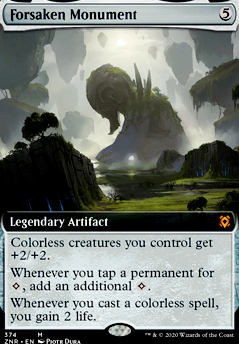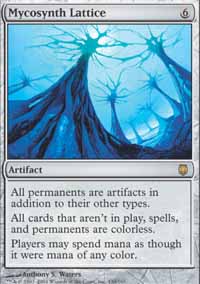
The set’s release marked the point when Mycosynth Lattice went from being a card that never ever saw any play in these two Eternal formats to suddenly becoming a quite prominent sideboard card. Correspondingly tracking the metagame data for Legacy and Vintage was a good way to determine that. Looking at a price graph for Mycosynth Lattice, it is very easy to pinpoint two significant events that have affected the card: the spoiling of War of the Spark at the beginning of April 2019 and the actual release of the set a month later. Mycosynth Lattice continued to increase slowly but steadily once again, bringing it to its all-time high, when a reprint in Battlebond (June 2018) first sent it nosediving on a downward slope for the following 10 months before everything turned around. Following these upward jumps, the card price plateaued at its new level. It nearly doubled around the time Dragon’s Maze came out on May 2013 and saw further sudden increases close to the release of Journey into Nyx on May 2014 and Aether Revolt on January 2017. Its price mostly crawled upwards slowly due to the card’s uniqueness and the fact that it had only been printed once. Its odd effects of turning every permanent into an artifact, making all cards not in play colorless, and letting everyone spend all their mana as if it was mana of any color made it unpopular. Once in a while, a new expansion would come out and make it a little stronger in Commander, which was the only place it really saw any play owning to its six-mana casting cost.

TAG Theoretical and Applied Genetics Springer Journals Originally printed in the February 2004 expansion Darksteel, Mycosynth Lattice lived a quiet and little noticed life for most of its first 15 years. Implications for risk assessment of genetically modified wheat are discussed. Subsequently these markers were used to characterise introgression of wheat DNA into a BC1S1 family. Successfully located RAPD fragments were then converted into highly specific and easy-to-use sequence characterised amplified regions (SCARs) through sequencing and primer design. Their presence indicates that DNA from any of the wheat genomes can introgress into Ae. Introgressed fragments were not limited to the D genome of wheat, but specific fragments of A and B genomes were also present in the BC1. cylindrica chromosome number or one supernumerary chromosome, were assigned to wheat chromosomes using Chinese Spring nulli-tetrasomic wheat lines. cylindrica as the recurrent parent and having a euploid Ae.

Wheat random amplified polymorphic DNA (RAPD) fragments, detected in intergeneric hybrids and introgressed to the first backcross generation with Ae. cylindrica because during meiosis in pentaploid hybrids, A and B genome chromosomes form univalents and tend to be eliminated whereas recombination takes place only in D genome chromosomes. It has been proposed that the A and B genome of bread wheat are secure places to insert transgenes to avoid their introgression into Ae. cylindrica share the D genome, issued from the common diploid ancestor Aegilops tauschii Coss. Introgression from allohexaploid wheat ( Triticum aestivum L., AABBDD) to allotetraploid jointed goatgrass ( Aegilops cylindrica Host, CCDD) can take place in areas where the two species grow in sympatry and hybridize.

hybrids Introgression of wheat DNA markers from A, B and D genomes in early generation progeny of. Introgression of wheat DNA markers from A, B and D genomes in early generation progeny of Aegilops cylindrica Host × Triticum aestivum L.


 0 kommentar(er)
0 kommentar(er)
